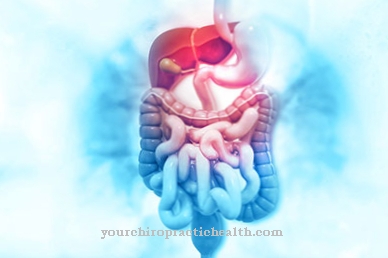Although the pest No longer occurs in Germany today, it is nevertheless known to almost everyone due to its history. The plague epidemics of the Middle Ages in particular got stuck in people's minds. In some countries, however, there are still isolated cases of the sub-form of pulmonary plague. Check with your doctor if necessary.
What is plague

© torook - stock.adobe.com
The pest is a disease caused by the bacterium Yersinia pestis, which occurs in four different forms: the bubonic, lung or abortive plague and plague sepsis. Plague meningitis occurs less often when the plague pathogens affect the meninges. Most people consider the plague Black Death Known from the Middle Ages - it is now widely accepted that the historically documented plague waves can actually be ascribed to the pathogen Yersinia pestis. However, most forms are treatable today.
causes
The causative agent of pest is a zoonosis, an animal-borne pathogen. Rats are the most well-known vectors, but squirrels, marmots and similar rodents can also be dangerous. Yersinia pestis is not transmitted directly from the rodent itself, but through the bite of its fleas. The bubonic plague is usually caused by such a flea bite and occurs a few hours to seven days afterwards. It is accompanied by severe drowsiness, fever and purulent or blue-colored swellings of the lymph nodes.
This can result in plague sepsis, in which the bacteria penetrate the bloodstream, release toxins, die and lead to death there after 36 hours at the latest due to internal and external bleeding. However, it can also lead to abortive plague due to the flea bite - only a slight fever and feeling of illness occur, after which the patient is immune to all pathogens. Pulmonary plague, however, in which Yersinia pestis affects the lungs, is still extremely dangerous today.
Symptoms, ailments & signs
In around 90 percent of cases, the symptoms of bubonic plague appear when infected with the plague pathogen. The first symptoms appear about two to six days after infection. Those affected suffer from a high fever, chills, headache, body aches and a very strong feeling of illness.
The bumps that give the bubonic plague its name develop as a result of infected and inflamed lymph nodes. They swell up and hurt. The infection leads to severe suppuration, which ultimately leads to the disintegration of the inflamed lymph nodes. These can also break open outwards - through the skin.
Other symptoms follow when the inflamed lymph vessels and nodes infect the circulatory system. This can lead to sepsis. If Yersinia pestis reaches the lungs, it leads to pneumonic plague with shortness of breath and bloody sputum. The symptoms of plague sepsis, on the other hand, can affect the entire body.
Infections of various organs, skin bleeding, digestive problems, enormous fatigue and shock reactions occur. Plague sepsis is a symptom that is to be expected in the course of an untreated plague infection. Plague sepsis is almost always fatal. Even in rare cases, the plague can show very weak symptoms that are hardly dangerous.
Diagnosis & course of disease
Almost any form of pest starts with fever up to chills, general malaise and drowsiness. The incubation period is a few hours up to 7 days, in the case of pulmonary plague 1-3 days. To distinguish the form of the plague, it is necessary to pay attention to the specific symptoms. In bubonic plague, for example, these are the swollen lymph nodes that turn purulent yellow to blue.
Shortness of breath, black-blooded sputum and pulmonary edema are characteristic. Plague sepsis can result from both forms or cause pneumonic plague in the first place, which is why it must also be recognized. It manifests itself in an intensification of the general symptoms of the disease, and headaches can also occur. Only the abortive plague is quite harmless: at best, it can resolve itself after it has shown mild, unspecific symptoms.
Complications
The extent of the plague depends on the particular form. The symptoms of abortive plague are relatively minor. However, with other forms there is a risk of serious complications. The risk is particularly high if there is no medical treatment for the plague.
One complication that can result from bubonic plague is pulmonary plague. Doctors speak in this case of a secondary pneumonic plague, since the more common primary form is transmitted by droplet infection. The pulmonary plague takes a rapid course and sometimes shows up after a few hours. However, the secondary lung plague progresses more slowly than the primary form.
Typical signs are fatigue, chills, fever, headache, muscle pain and dizziness. On the second day of the illness, cough with black-blooded sputum, chest pain, breathing difficulties and a blue discoloration of the skin are added. Abdominal pain, diarrhea, nausea and vomiting are not uncommon.
From the pneumonic plague as well as from the bubonic plague, skin plague, plague meningitis or plague laryngitis a life-threatening plague sepsis can develop. In around ten percent of all plague patients, the plague bacteria penetrate into the blood, where they cause blood poisoning. The plague sepsis is noticeable through lethargy, high fever, digestive problems and a drop in blood pressure.
In addition, the sick person reacts confused. Furthermore, the plague sepsis can cause vascular occlusions, which affect the blood supply to the organs. In extreme cases, the patient dies.
When should you go to the doctor?
The plague is one of the diseases that has not occurred in Germany for a long time. Nevertheless, a visit to the doctor is advisable if the person concerned is convinced that they are suffering from this deadly disease. Headache and body aches, a very high body temperature and a feeling of illness are signs of an irregularity that should be investigated. If there are other flu-like symptoms such as chills, fatigue and tiredness, a doctor is recommended.
If there is discoloration of the skin, suppuration or swelling of the lymph glands, action is required. Sepsis can occur. This creates a life-threatening condition. Shortness of breath, bleeding of the skin and a bloody sputum must be examined and treated as soon as possible. If the existing complaints increase, the person affected needs immediate help. In the event of a disturbance of consciousness or a state of shock, an emergency service must be alerted. Since the plague is a highly contagious disease, the instructions of the emergency doctor should be followed.
If left untreated, the disease can spread quickly and infect countless people. In addition, there is a potential risk to life for the sick person, since the course of the disease ends fatally within a short time without medical care.
Treatment & Therapy
The pathogen Yersinia pestis is a bacterium, which is why the basis of the treatment is pest based on antibiotics. The drug of choice is streptomycin, which is given intramuscularly while the patient is under inpatient surveillance. Rapid treatment is particularly important for pneumonic plague, as it still has an extremely high mortality rate today.
If streptomycin cannot be used or if the effect has to occur very quickly in order to still be able to help the patient, chloramphenicol is used, which is, however, the last possible treatment option. It is known for its powerful side effect, aplastic anemia. Although this only occurs in one in 6,000-36,000 cases, especially with the plague it is a risk that should not be underestimated. Depending on the severity of the symptoms, these are also treated - for example, high fever can be reduced, pain can be relieved with medication.
Aftercare
After contracting the plague, patients are usually immune to re-infection. In addition, there is no need for long-term treatment and everyday support. The symptoms subside completely. The affected person returns to his everyday life. Follow-up care is mainly related to protecting other people.
The easy transferability of the plague led to the death of entire regions in the Middle Ages. Patients with an established disease must remain in isolation for several days after the symptoms have ceased. A blood test provides information about whether the pathogen is still in the organism.
The best aftercare strategy is avoiding sick people and animals. Patients are responsible for this. Anyone who travels to risk areas can be vaccinated against certain pathogens. However, the active ingredient only provides short-term immunity.
In contrast to cancer, the plague cannot develop from the body itself. The isolation of sick people as described above is the most effective means of combating infection. If the plague breaks out in Europe, state authorities ensure quarantine. Patients must strictly follow the instructions of the medical staff.
Outlook & forecast
In contrast to earlier times such as the Middle Ages, when the plague depopulated entire areas, the prognosis for the infectious disease is more favorable in the present. However, the outlook also today depends on the form of the disease and whether it is treated in good time. If, for example, it is an abortive plague, it is a mild form of plague with a positive prognosis. This is how the body's defense system produces antibodies that ensure long-lasting immunity.
If the patient suffers from the bubonic plague and if it is treated at the right time, the chances of recovery are good and the affected people survive the serious illness. However, if there is no timely therapy with antibiotic drugs, between 50 and 60 percent of those affected will die. The drugs must be administered after approx. 15 hours at the latest.
The prognosis is particularly unfavorable if plague forms such as pulmonary plague or plague sepsis are present. The patients often do not receive rescue therapy in good time. However, if the diagnosis is made early and the plague is treated with antibiotics, the death rate for both pulmonary plague and plague sepsis is reduced by around 15 percent.
Typically, if the person survives the disease, the person affected will have high immunity to the plague. In some patients, however, plague outbreaks reappear later.
You can do that yourself
The plague is considered a disease that has been eradicated in Germany. Due to changed hygienic conditions in the last hundred years as well as medical progress, the plague is only known to current generations through historical traditions. Nevertheless, caution should always be exercised when dealing with wild animals.
Direct skin contact with squirrels or rodents of any kind should be avoided in the wild. Rats in particular can transmit the disease-causing bacteria. Since the plague is a life-threatening disease, see a doctor at the first signs and symptoms. Independent treatment or taking self-determined measures to alleviate the symptoms is not advisable. The treating physicians should be fully informed of the cause and the course of the transmission. The plague is a reportable disease that is treated by specialist doctors.
In the very unlikely event of illness, the doctor's instructions must always be followed so that your own health can improve quickly and no further complications arise. Since the risk of infection is very high, handling and physical contact with other people should be avoided. The patient is placed in a quarantine station so that the pathogen cannot spread further in the population.






.jpg)




















